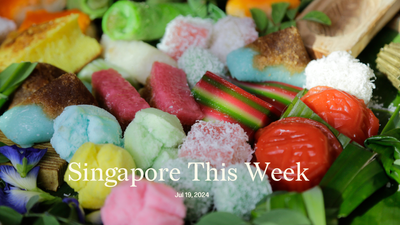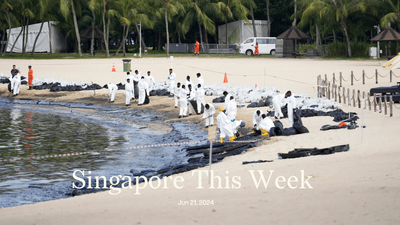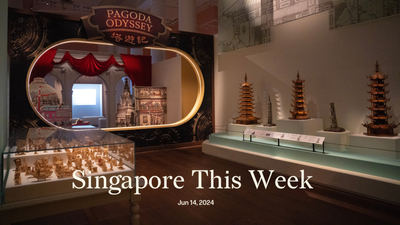Politics: Lawrence meh
Mainstream reporting suggests that Lawrence Wong, Singapore’s next prime minister, has been strumming his way into our hearts. But a recent YouGov survey of 1,025 Singaporeans sings a different tune. When asked about their feelings when they heard the news of the political handover, a huge plurality (36 percent) said they feel nothing at all. Small segments expressed one of the three positive emotions—20 percent are hopeful, 13 percent confident, and 12 percent happy—for a combined total of 45 percent. This could be indicative of general political apathy. Two other questions were more specific to Wong. Even though over three-quarters of respondents say they have at least “some expectation” for his leadership, their ranking of his different characteristics may give him the blues. YouGov asked if Wong is competent; trustworthy; likeable; a strong leader; honest; and charismatic. The only attribute for which a majority (53 percent) agreed is competency. Wong shouldn’t fret too much though. He can, indeed, be a transformative leader who wins over more Singaporeans. But his cause won’t be helped, as Jom earlier suggested, if the “3G” leaders, particularly Lee Hsien Loong, outgoing prime minister, are breathing down his neck. Wong may want to pluck some out of his cabinet. Otherwise Singaporeans might feel like he’s just stringing us along.
Politics: When Rajahs fight
“The Economist can’t resist sneering at us,” wrote K Shanmugam, home affairs and law minister, on Facebook last week. “It’s an instinct lodged deep in the unconscious of the British commentariat class. They can’t stand that a people they were accustomed to lecturing are now doing better than they are, across the board.” He was responding to a “Banyan” opinion column about Wong. (Disclosure: Dominic Ziegler, the columnist, was one of four in a Jom advertising campaign last year, for which he received a bizarre government warning.)
Shanmugam cited data to show how Singaporeans are “doing better” than our former colonial master in six realms of life. This kind of reductive whataboutism doesn’t promote constructive visions of human betterment. In our view, the post is misguided for a few other reasons. The column actually speaks quite highly of Wong. Moreover, The Economist is an international publication, not one that owes any fealty to the British state (unlike, say, the BBC). It’s long been critical of the very things Shanmugam mentions, including the funding of Boris Johnson’s home renovations. Major media outlets hire many Singaporeans here: Farah Cheah at The Economist, Shibani Mahtani at The Washington Post, and Wong Chun Han at The Wall Street Journal, to name just three. Are we to assume that they’re part of some Anglo-Saxon “commentariat class”? This conflation of national and corporate agendas may be applicable to Singapore’s mainstream media. But it’s rarely the case globally, and is corrosive to healthy, critical dialogue—nationalist fervour risks both blinding Singaporeans to good writing, and scaring off writers. We all lose out.
To be sure, the fear of foreign interference is an instinct lodged deep in the unconscious of the Singapore governing class. In 1960, the CIA offered a US$3.3m bribe—equivalent to almost US$35m (S$47.7m) today—to Lee Kuan Yew so that he’d cover up a failed American plot to turn a Singapore intelligence officer. In the subsequent decades, his paranoia sustained a dragnet that caught alleged communists and others, including Ang Swee Chai, a doctor, and Ho Kwon Ping, then journalist and later founder of Banyan Tree. In recent years, the focus has been on those with ties to Beijing, particularly academics and businesspeople. These occasional swipes at the British, including Richard Branson and Ziegler, may have the unintended benefit of exhibiting “fair” treatment of suspected foreign threats. It’s probably good that Singapore isn’t seen to only target China.
Singapore’s relationship with the British is complicated, partly because our colonial experience was not as severe as elsewhere in the region—merchants of all ethnicities reaped riches in the “jewel of the east”, including from the opium trade. Vestiges of affection are everywhere, including our language, Parliament’s mourning of Queen Elizabeth II in 2022, and the two things politicians are particularly fond of: Raffles Institution and colonial bungalows. There are indeed genuine threats around—best that “Shan” helps us ride out those.
Society: Back to bed
On March 23rd 2022, Wake Up, Singapore (WUSG), an alternative news site with sizeable followings on Facebook and Instagram, published a woman’s unverified claims that she had suffered a miscarriage at the KK Women’s and Children’s Hospital (KKH) after being forced to wait for four hours for treatment. Its post included a February 28th hospital bill with the name redacted. On March 24th, KKH put out two statements, saying that it takes the allegation seriously but is seeking more information since it’s unable to identify the patient. KKH then filed a police report, which prompted WUSG to question the lady, who finally came clean about her fabrications. On March 25th, WUSG deleted the posts and published a blow-by-blow account of what transpired. “We seek your forgiveness, and we are again sorry for letting you down.”
And on March 27th 2022, it was hit with a correction direction from the Protection from Online Falsehoods and Manipulation Act (POFMA) Office. “Notwithstanding WUSG’s apology, the allegations are serious and have been circulated to various other platforms,” said the Ministry of Health. “This could lead to the erosion of public trust in the credibility and professionalism of our healthcare system and institutions.” The POFMA statement, unusually and ominously, hinted at the ongoing police investigation.
On Wednesday, more than two years later, Ariffin Sha, WUSG’s founder and administrator, was charged in court for criminal defamation, which carries a maximum penalty of a two-year jail term and/or a fine. WUSG is known for its stridently non-establishment viewpoints, often shining a light on marginalised groups such as migrant workers. Some online wondered if the timing of the charge is related to the upcoming election, which must be called by November 2025, but which may be as soon as this year. This timing concern is analogous to the recent charges against Pritam Singh, Workers’ Party chief, for allegedly having lied to a parliamentary committee in 2021. But the judicial system is independent from politics and the electoral cycle. A separate corruption case involving S Iswaran, former minister with the ruling People’s Action Party (PAP), is also wending its way through the courts. Whatever happens, we hope it doesn’t deter WUSG’s important work. Since it was founded in 2013, it has, true to its name, opened the eyes of many.
Society: Power to the People at Hong Lim Park on May Day
“A different future is possible, but only if we fight for it. Will you fight with us, this Labour Day?” asks Workers Make Possible (WMP), ahead of next Wednesday’s Labour Day Rally at Hong Lim Park. It’s a follow-up to last year’s incredibly successful inaugural edition by the workers’ rights group. WMP came to prominence in 2022, when it brought to light complaints by workers at Watsons, a pharmaceutical chain, about their inability to sit down and rest, which sparked similar complaints by retail staff elsewhere about “no sitting” policies. This year’s edition focuses on burnout in “a culture that asks too much of us and makes us feel like we can never be good enough.” Music will be provided by Satu Jiwa (“one soul” in Malay), an “intergenerational band, with members ranging from the Old Left to present-day student organisers”. We can expect the same mix of passion, solidarity and celebration. Long gone are the days when angst was the main currency traded on Hong Lim’s green lawns. Presumably the artists being made to work on a public holiday will be allowed to sit between sets. May 1st, 3-7pm, Hong Lim Park. We hope to see some of you Jomrades there.
Some further reading: In “Power to the People: Labour Day Rally 2023”, Jom profiled Staffan Stewart, a nurse, Suraendher Kumarr, a community worker and researcher for WMP, Swanhilda Kaur, an F&B worker, Peter Yeo, a food delivery rider, and Chua Qwong Meng, formerly a bus driver.
Society: Time to flex your flexi work muscles?
Flexibility is the new currency in the workplace. Forced into lockdowns and other restrictions during the Covid-19 pandemic, today’s workforce has since grown accustomed to having more control over the way they work, making them less willing to accept a traditional office job. In its 2024 Workmonitor survey, international recruitment agency Randstad found that 49 percent of Singapore’s workforce would leave jobs that require them to work in the office more often. Of this average, 69 percent of Gen Zers agreed with this statement, compared with 47 percent of Millennials, 44 percent of Gen X and 45 percent of Boomers—highlighting a generational gap in expectations. Gen Zers were also most likely not to accept a job that’s too inflexible around work hours (68 percent) and location (61 percent). “It’s about enabling people from different generations to thrive, not just individually but also collectively,” said Archana Srinivasan, a human resources (HR) director, in a CNA interview. The biannual survey was conducted online last year in over 30 countries among 27,000 respondents aged 18-67, including about 760 workers and job seekers in Singapore. Work-life balance has also become a higher priority for employees than salary (95 percent compared to 90 percent respectively), with 46 percent saying that hybrid work is non-negotiable for them. “Having a holistic understanding of their workforce’s unique priorities is critical for employers to offer the flexibility and diversity they need,” said Randstad.
The survey results were released days after the government announced that all employers must fairly offer their employees the ability to request for flexible work arrangements (FWA) from December. The new Tripartite Guidelines on Flexible Work Arrangement Requests formalise and clarify processes to make this happen. “They enable employees to achieve better work-life harmony, and give employers a competitive advantage in talent attraction and retention,” explained Gan Siow Huang, minister of state for manpower, and co-chair of the Tripartite Workgroup. Even though employers will still have the prerogative to grant an FWA or not, the guidelines place workers in a better position to ask for more flexible work options, including a four-day work week, more work-from-home days, and even job sharing, in Singapore’s tight labour market and ageing society. But there are concerns that the new guidelines could end up hurting the local workforce instead: some companies have said that they may consider hiring more staff overseas for less if remote work becomes increasingly common. The days of obligatory office “face time” may be (phew) long gone. But workers should be cautious about taking FWAs too far.
Society: Tele toker
“Helluuu will send tonight? If not I go sleep alr,” read a Telegram message sent by a local drug client to his supplier. His order was eventually delivered and chucked behind a freezer box at the rubbish chute below his block, hidden from plain sight. Before the rise of online messaging platforms like Telegram, drug users would have had to go to red-light districts like Geylang in order to access these substances, possibly running into the police in the process. Now, ordering drugs can be as easy as ordering pizza, according to one former cannabis user. Local suppliers on private chat groups offer both legal (cough syrups, painkillers, sedatives etc) and illegal (weed, ice, heroin, ecstasy etc) drugs to substance abusers, and for a small fee, can deliver it to them in a couple of hours.
Some 3,981 inmates are in drug rehabilitation centres (DRC) as of 2023, the highest number since 2008. According to the Singapore Prison Service, this inmate population increased after the Misuse of Drugs Act in 2019 was amended to differentiate between drug abusers who commit harmful offences to society and those who only consume drugs. Individuals belonging to the latter group are channelled to various rehabilitation pathways, including the DRC. Worryingly, the DRC saw a 17 percent increase in young drug abusers in 2023 compared to the previous year. “I saw people taking drugs who were younger than when I first started. Like the age of 14,” one DRC inmate told The Straits Times (ST). Easier access to drugs and the global liberalisations could be reasons why.
“We are surrounded by sensationalised narratives and misinformation about drugs,” said Muhammad Faishal Ibrahim, minister of state for home affairs, at an anti-drug seminar last week. “...[A] whole-of-community effort is needed to shape young people’s attitudes about drugs and tackle increasingly…liberal views on illicit substance use.” Part of this effort now includes an expansion of preventative drug education under local school curricula, and the repetition of anti-drug messages at institutes of higher learning during orientation programmes and before overseas trips. Will our longstanding zero-tolerance, fear-mongering, hard anti-drug messaging successfully deter this generation of young Singaporeans from using illicit drugs? Given the generational divide in attitudes towards drugs, Singapore may have to adopt a more nuanced, frank conversation about substance use for younger people.
History Weekly by Faris Joraimi
Commercial tenants of Pearl’s Hill Terrace, a military barracks which now houses an “indie art enclave”, will be evicted next year as the site has been earmarked for residential redevelopment. This place’s history predates Stamford Raffles, as part of the old international economy of the Malay world; Chinese gambier planters worked the soil of its slopes, authorised by the Temenggung of Johor. Along came James Pearl, a captain in Raffles’s fleet, who wanted to build a house on the hill because he liked the view. Resident William Farquhar said “no”, because the site was already occupied, but Pearl bought up the hill little by little until, in one account, the last holdout gave in for a barrel of rum. The story—whether apocryphal or not—contains a common motif, of prime real estate changing hands for a pittance. It abounds elsewhere; the Dutch were said to have bought Manhattan from the Lenape people for twenty-four dollars’ worth of beads (not true), while Alaska was bought from the Russians for two cents per acre (true).
Then there’s the classic ruse of large territory taken with a little animal skin, which is how a Malay account from around the late 17th century presents the Portuguese seizure of Melaka (1511). Against the wise counsel of his ministers, Sultan Ahmad Shah of Melaka agreed to the white men’s request for land only the size of an ox’s hide. The hide was brought, but cut into a long cord tracing out a square so large, the Portuguese could build a fort in it loaded with cannon and muskets. Do something, said the ministers to their king. The king replied: the white men are few and will not ruin our land; we will act if they show evil intentions. The Portuguese duly bombarded and captured Melaka.
According to the historian Sanjay Subrahmanyam, this trick to enlarge land appears in mythology across Asia, North Africa and the Mediterranean, and also shows up in the Aeneid, a Roman epic poem. Native North Americans also tell versions of the “ox-hide purchase”. They all condense history into a shared truth, about conquest as an abuse of hospitality. But also that land has shape-shifting value, worth only as much as what invented institutions assign to it, whether agreed-upon or imposed. With the HDB flats ready in 10 years’ time, you too could own a spot on Captain Pearl’s Hill. You’ll have to pay much more than a barrel of rum—maybe something closer to the size of an ox-hide.
Arts: Newest (and richest) book prize for biography of oldest living pioneer artist
Every week for nine months, the centenarian artist Lim Tze Peng could count on a visit from writer-producer Woon Tai Ho. Woon, perhaps best known for launching Channel NewsAsia, also interviewed over a hundred people for Soul of Ink: Lim Tze Peng at 100, observing the elderly painter as he met with collectors, curators, gallerists and friends. These long-term commitments paid off. Woon’s meticulous profile of the self-taught artist and former school principal clinched the inaugural S$30,000 “Dr Alan HJ Chan Spirit of Singapore Book Prize” earlier this week. The prize was named for the late entrepreneur who donated S$1m to the Singapore University of Social Sciences, which presents the award. The Epigram Books Fiction Prize was hitherto the frontrunner for generous prize money, with S$25,000 set aside for the winning manuscript. (The Golden Point Award carries a top prize of S$6,000, and the Singapore Literature Prize, S$3,000.)
A prize is also what kept Lim going. He won his first-ever accolade, at 56, for a tropical Balinese scene at the 1977 Commonwealth Art Exhibition in the UK. Until then, he told ST, “I had doubted myself. No one said I was good and my paintings did not do well. But after I got the prize, I had renewed confidence and I knew that I could walk this road.” Lim, now 102, is known as a relentless and prolific producer of artwork: delicate, ink-washed landscapes of Singaporean kampungs alongside crowded scrolls of jagged, forceful calligraphic strokes. He went from scrubbing school toilets to rubbing shoulders with the likes of Nanyang-style artist Cheong Soo Pieng, and received the Cultural Medallion well into his 80s. Part of the book prize’s ethos is a celebration of the “Singapore Spirit”, stressing “the importance of social good” alongside ideals of “resilience” and “pragmatism”. But perhaps it’s Lim’s insistence on what may seem “soft” and “impractical”—buying art books on the sly, cajoling his children into grinding inks for him, his adoration of his wife—that is the real Singapore soul.
Arts: Continental cinema, archipelagic affinities
A crane pivots slowly over a high-rise building under construction. A group of migrant construction workers crack open cold beers in a park after a long day at work. At sunset, they huddle at the back of a bus on the way home, exchanging plans for an upcoming holiday in a shared language they’ve picked up while working in a foreign land. Except this isn’t Singapore—it’s the opening scene of “Here”, the award-winning Belgian film that opened the 33rd European Union (EU) Film Festival at The Projector (Cineleisure) earlier this week. One of the longest-running foreign film festivals in Singapore, its sprawling schedule packs 24 films from 24 countries into the span of a month. From sweeping historical epics to biting crypto satires, the festival’s main selling point seems to be its wilful eclecticism in terms of genre, form and subject matter. Programmed alongside the feature film lineup is an equally wide-ranging array of short films by emerging Singaporean filmmakers from tertiary institutions.
Supra-national unions such as the EU and the Association of Southeast Asian Nations (ASEAN) are often used as a reductive shorthand for the regions they represent. Festivals such as these offer an opportunity—while still subject to the niceties of cultural diplomacy—to showcase slice-of-life reflections and socioeconomic urgencies from across the continent. These, in turn, offer us a different vantage point from which we might (re)connect with our own archipelago. Clarissa Oon, Esplanade’s head of communications and content, observed in her keynote at the 2019 Asian Arts Media Roundtable that the buoyancy of Western European arts media was produced by affluence, a common market, strong arts and culture recognition and patronage, as well as freedom of expression—while pointing out the drastic asymmetries in the same factors across Asia. “What needs to be considered when talking about Asian arts media,” she said, “is that there is no one Asia but many Asias.” In the wake of Brexit and the refugee crisis, and the themes of migration, inequality, intimacy and kinship that the film festival threads together, we’re given a glimpse of not one Europe, but many Europes.
Tech: Another robo-advisor runs out of juice
After Temasek Trust’s dramatic acquisition of robo-advisor MoneyOwl, another Singapore-based robo-advisor has run out of juice. In the final moments of last year, Bambu’s journey ended abruptly after investors and management decided to pull the plug given its inability to turn a profit. This is despite Bambu having made progress towards near profitability earlier in the year. This scenario underscores the precarious path of robo-advisory services, which have seen fluctuating interest levels over the years. Bambu’s attempt to pivot towards sustainability through the launch of Bambu Go—a customisable robo-advisor aimed at mass retail investors—highlights the firm’s strategic efforts to diversify income and reduce reliance on variable project-based revenue. However, this was hampered by rising interest rates and compounded difficulties in securing new enterprise deals, which were critical for Bambu’s survival and growth. Bambu’s closure also sheds light on the importance of balancing sales prowess with operational and technological excellence. Despite securing significant clients and investment, including at least US$13.4m (S$18.2m) in funding from Wavemaker Partners and Franklin Templeton Investments, the start-up struggled with operational and technological challenges till late in its lifecycle. This imbalance, coupled with an ultimatum set by its investors and management, led to its untimely dissolution. Bambu’s story is a sobering reminder of the volatility facing start-ups, even those on the cusp of profitability. It emphasises the need for start-ups to maintain a keen balance between innovation, market suitability, operational efficiencies, and financial health to overcome the stacked odds for any early stage company.
Tech: Apples in a big SEA
While Lee Hsien Loong has announced that he is stepping down as prime minister, his Ang Mo Kio constituents are getting a big ang pao with Apple’s latest announced investment of over US$250m (S$340m) to expand its Ang Mo Kio campus in Singapore. This underscores the tech giant’s long-term strategy to solidify its presence in Singapore to serve as its central operations centre in the region. By integrating three unique spaces to enhance collaboration among its growing teams, Apple aims to bolster creativity and synergy across its software, hardware, services, and support functions. This expansion is not just a physical extension but a testament to Apple’s relationship with Singapore, which dates back to 1981, and its dedication to fostering job creation and community engagement. Since 2019, Apple has grown its hardware technologies centre space by over 50 percent. Besides the Ang Mo Kio campus, Apple currently has three stores in Marina Bay Sands, Orchard Road and Jewel Changi. The focus on developing new roles in artificial intelligence and other key areas highlights Apple’s forward-looking approach to cementing its position at the cutting edge of technology. Sustainability is also at the forefront—its expanded campus will run completely on renewable energy. The latest announcement comes on the back of discussions to establish a manufacturing facility in Indonesia, which occurred when Tim Cook met Joko Widodo, the country’s outgoing president. The technology behemoth clearly has intentions to diversify its manufacturing base and deepen its ties in South-east Asia, a particularly important priority for companies caught between rising US-China tensions and a decoupling of supply chains. This move, along with efforts since 2018 to foster the iOS app economy and app developer academies, signify Apple’s ambition to expand its technological footprint and innovation capacity in the region.
If you enjoy Jom’s work, do get a paid subscription today to support independent journalism in Singapore.







